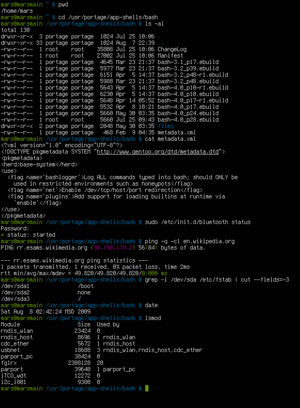Unix shell facts for kids
A Unix shell, also known as a terminal or console, is a special computer program. Think of it as a way for you to "talk" to your computer using text commands instead of clicking icons. It takes commands you type on the keyboard and makes the computer do them. These commands can be simple instructions like:
- ls to see a list of files in a folder
- cp to copy files from one place to another
- man to get help and more information about other commands
Sometimes, these commands don't even come from the keyboard! They can come from other programs or files. A Unix shell is a type of command line interface, which means you control the computer by typing lines of text. It's made especially for managing Unix systems, which are powerful computer operating systems.
There are many different kinds of Unix shells, but some of the most famous ones are bash, sh, C Shell, and zsh. Even though they have different names, they work in similar ways. For example, if you wanted to find out what kind of CPU (the "brain" of your computer) you have, you could type a command like this in almost any shell: cat /proc/cpuinfo | grep --max-count=1 "model name" This command would then show you something like: model name : Intel(R) Core(TM) i7 CPU 860 @ 2.80GHz
What is a Shell?
A shell is like a translator between you and your computer's operating system. When you type a command, the shell understands what you want to do and tells the computer to do it. It's a very powerful way to control your computer, especially for advanced tasks or for automating things.
How Do Shells Work?
When you open a terminal or console window, you're usually starting a shell program. You'll see a blinking cursor, waiting for you to type. This is called the "command prompt."
- You type a command: For example, you might type ls -l to see a detailed list of files.
- The shell interprets it: The shell reads your command and figures out what program you want to run and what information you're giving it.
- The shell runs the program: It then tells the operating system to start that program.
- The program does its job: The program runs and usually shows its results right there in the shell window.
Shells can also run scripts, which are like mini-programs made of many commands saved in a file. This is super useful for doing a lot of tasks automatically!
Types of Unix Shells
Over the years, many different Unix shells have been created. Each one has its own special features, but they all do the same basic job of letting you control the computer with text commands.
- sh (Bourne Shell): This was one of the first and most important shells. Many other shells are based on it.
- bash (Bourne-Again Shell): This is one of the most popular shells today. It's the default shell on many Linux systems and macOS. It has many helpful features like command history (remembering what you typed before) and tab completion (finishing commands for you).
- C Shell (csh) and tcsh: These shells were designed to be more like the C programming language, which some programmers found easier to use.
- zsh (Z Shell): This is a newer shell that combines many features from bash, tcsh, and other shells. It's very customizable and popular among developers.
Even though they have differences, if you learn how to use one shell, you'll find it pretty easy to pick up another because their basic commands are very similar.
Images for kids
-
tcsh and sh shell windows on a Mac OS X Leopard desktop
See also
 In Spanish: Shell de Unix para niños
In Spanish: Shell de Unix para niños



